
2023 H.R. Statistics: Hiring, Retaining & Rehiring
Stay ahead with these HR statistics and trends for 2023, covering HR's key issues, from employee engagement to retention.
The recruitment industry has changed.
The COVID-19 pandemic, the Great Resignation, and slippery market conditions have reshuffled HR trends. Some employees now hold more power thanks to new job openings, a stronger gig economy, and technological advancements that allow for remote work.
HR professionals should stay up to date with the latest trends. But looking for the right resource among hundreds of reports can take ages. You might be dealing with last year’s data that’s hardly relevant anymore.
So we did some digging for you. EnterpriseAlumni has compiled the most recent human resource statistics so you can easily stay up to date with the latest trends.
- Editor's Picks
- Job Openings Overview
- Recruiting
- Employee Engagement & Retention
- Employment Regulation
- Job Interviews
- Rehiring
- The Main Problems with Hiring, Retaining and Rehiring
Top Human Resources Statistics for 2023 - Editor's Pick
-
Companies spend $4,683 per new employee on average while hiring. For executive posts, this number can reach beyond $28,329 per employee. (10)
-
The cost of replacing one salaried employee can range up to 200% of that person's salary. (17)
-
Thirty states and U.S. territories have enacted laws prohibiting recruiters from requesting a candidate's salary history. (24)
-
Businesses save up to 66% on recruiting costs when hiring a boomerang employee compared to a new hire. (34)
-
New hires in specialty jobs are offered bonuses of up to $100,000. (47)
-
Businesses with engaged employees report 23% higher profit compared to businesses with disheartened workers. (3)
-
Nine out of ten employers say they struggle to fill positions due to skills gap. Skill gaps are among the top challenges employers face when hiring. (1)
Job Openings Overview
In a world that has been struggling with the aftermath of the COVID-19 pandemic, 2022 showed a slither of hope for the future of job markets. If you are looking to get started with finding work, now is the best time. And these statistics will prove it.
1. In 2022, 93% of employers planned to hire more staff, of which 41% planned to fill new positions and 51% to replace or backfill staff. (1)
2. According to the U.S. Bureau of Labor Statistics, the number of job openings in October 2022 was 10.3 million. (2)
3. Nine out of ten employers say they struggle to fill positions because of a skill gap. Skill gaps are among top challenges businesses face when hiring. (1)
4. By 2030, 85 million jobs could go unfilled because of a lack of skilled people. (48)
5. The top three industries with the highest net workforce increase are: Information media and telecommunications (69%), Not for profit (57%), and Healthcare and social assistance (54%). (18)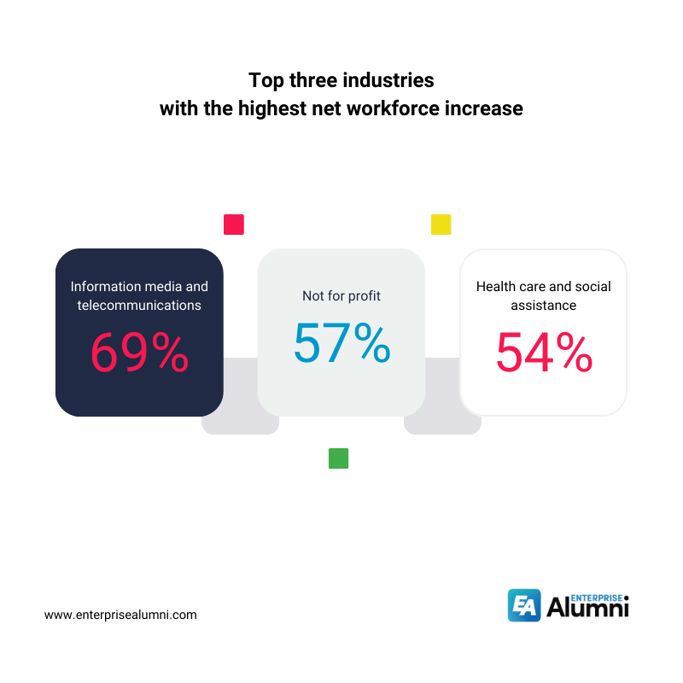
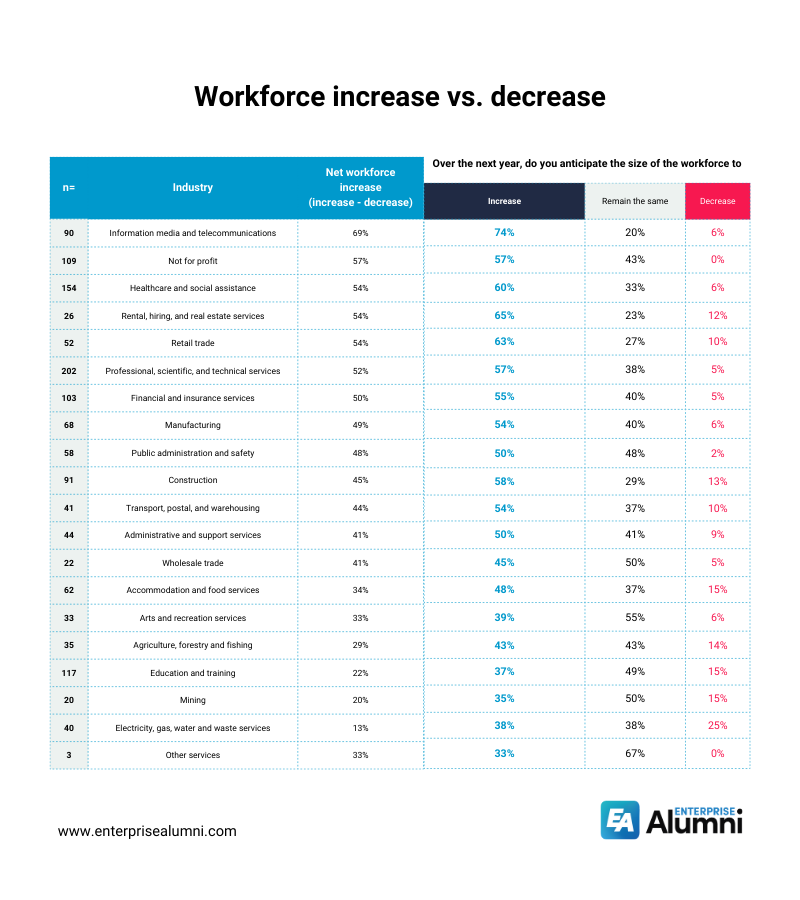
6. 45% of employees say that now is the best time to find a job. The United States and Canada (71%), Australia and New Zealand (59%), and South Asia (50%) are the top three best places to find a job right now. (5)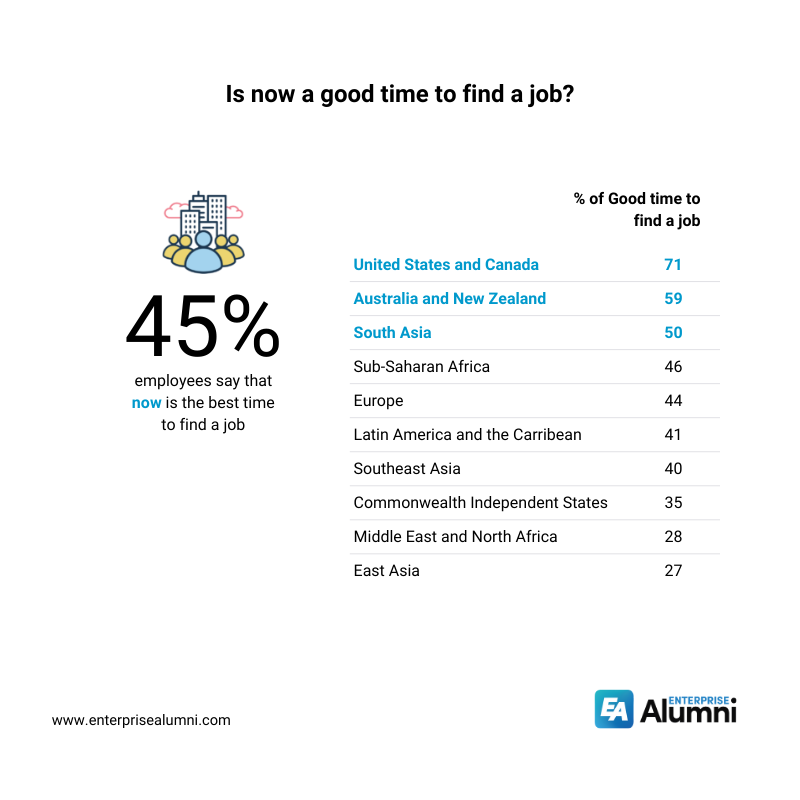
7. Automotive (60%), engineering (57%), retail (56%), and insurance/real estate (55%) are most likely to expand into new roles in 2022. (1)
8. According to Recruiter National Report, here are some ways employers are improving the recruiting process:
- 40% said that their recruiting budgets have increased, and 64% of employers expect them to increase in 6-12 months.
- 35% of organizations outsource more jobs to freelancers, and 54% plan to do so moving forward.
- 40% are making more internal hires, and nearly half are seeing participation in employee referral programs. (6)
9. There are now three times as many remote jobs as there were in 2020. Remote jobs now make up 15% of the total opportunities in the U.S. (7)
10. 91% of total employers today use social media in their hiring process. (8)
11. Most recruiters (72.6%) partner with campus clubs or diversity-focused partnerships to recruit diverse candidates. (9)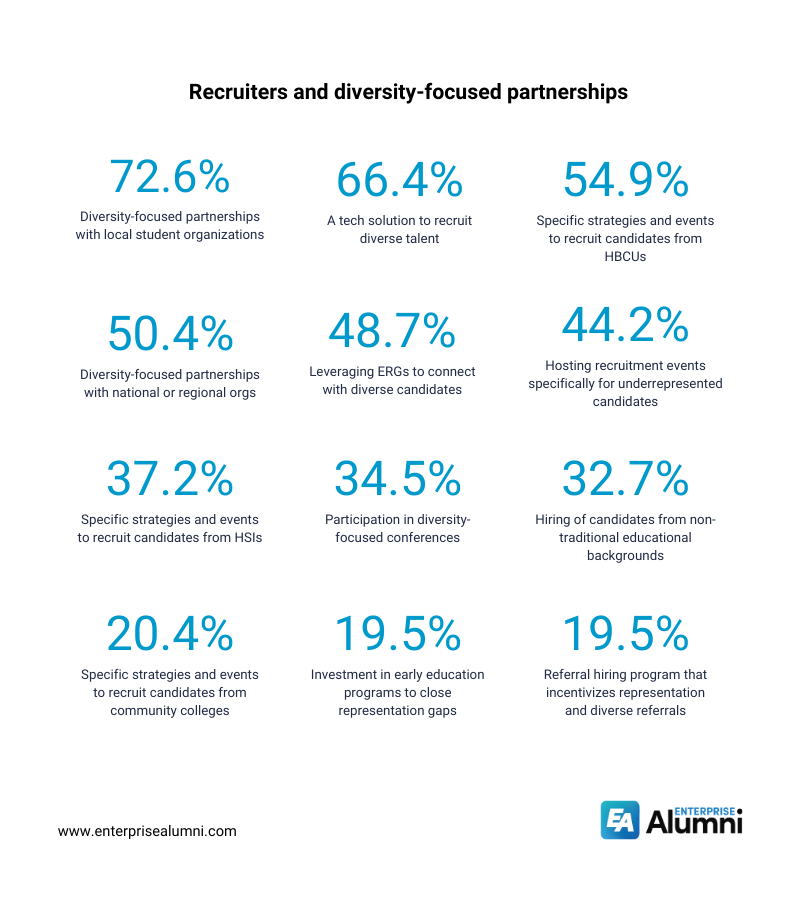
Recruiting Statistics for H.R. Departments
Understanding key recruitment statistics is crucial for knowing the latest hiring trends and retaining top talent in your company. Employers can use this data to guide their future hiring and stand out to potential employees.
12. Companies spend $4683 per new employee on average while hiring. For executive posts, this number can reach beyond $28,329 per employee. (10)
13. It takes an average of 41 days to hire across the industry, with engineering (49 days) being the slowest and administrative the fastest (33 days). (11)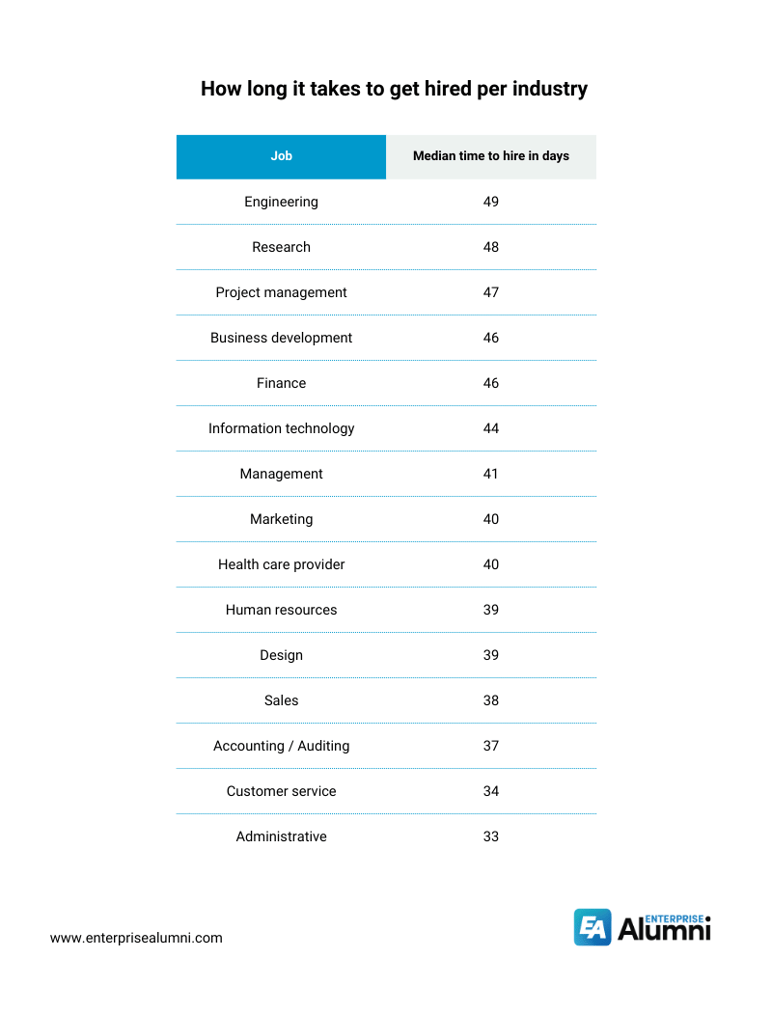
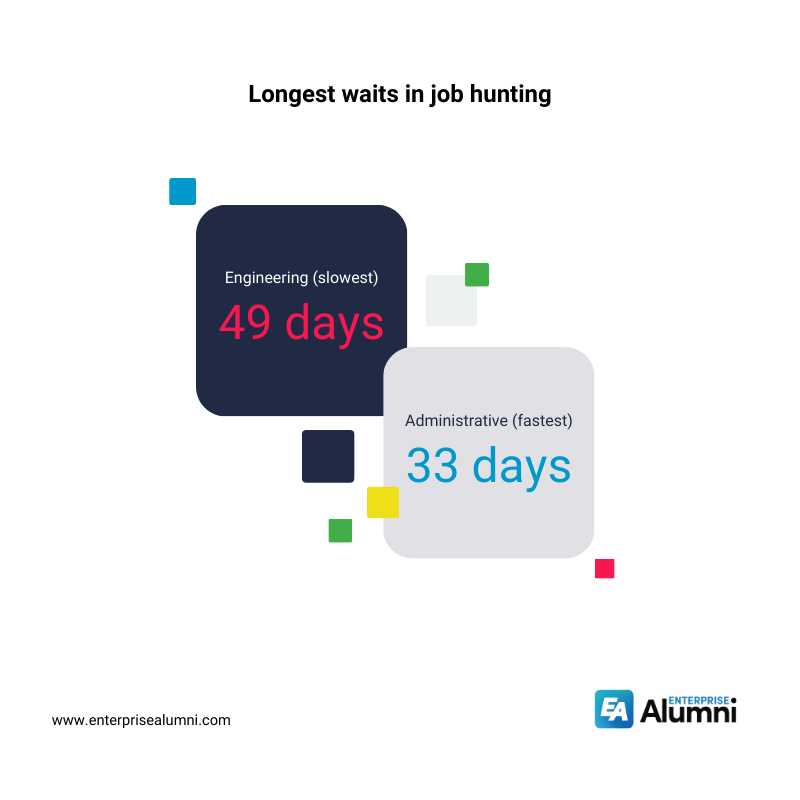
14. According to Jobvite, the top influences on rejecting a job offer are:
- Overall compensation (38%)
- Company locations accessibility (27%)
- Flexibility to work from home/remotely (22%) (12)
15. On average, 118 people are applying for the same vacancy. In a corporate setting, this number can go over 250 applications. (13)
16. The top resources for workers to find out about job openings were:
- Online job boards (59%)
- Friends (46%)
- Social media such as LinkedIn and Facebook (39%)
- Employer career sites (33%)
- Professional connections (25%)
- Career fairs (23%) (12)
17. 40% of job seekers would be willing to accept a lower salary offer to work remotely. (12)
18. 25% of workers have interacted with new technologies like chatbots during recruitment. Out of these, 80% have rated the experience as good or very good, and 63% believe that it has improved their recruitment experience. (12)
19. Employers have reported remote options, leveraging culture, and flex hours as the top 3 most popular recruitment tactics. Remote options have been used 24.7% more than wage increases to attract more candidates. (14).png?width=800&height=800&name=Recruiting%20tactics%20(2).png)
20. According to LinkedIn, an employer with a strong personal brand saves 43% of the cost of hiring. (15)
21. Diversity, equity, and inclusion (DE&I) practices were the top priority for HR teams in 2022. More than 75% of people looking for work said that diversity was an important factor when judging companies and job offers. And 39% of candidates reject an offer due to a lack of inclusiveness. (48)
22. New hires in specialty jobs are offered bonuses that can extend to $100,000. (47)
Employee Engagement & Retention Statistics
Employee engagement measures how happy and motivated your employees are at work. This helps businesses build effective strategies to improve work culture, ensure productivity, and reduce staff turnover.
23. Businesses with engaged employees have 23% higher profit compared to business units with disengaged workers. (3)
24. Companies with highly engaged workforces earn 2x higher net income and 2.6x per-share level compared to businesses with low engagement levels. (16)
25. The cost of replacing one salaried employee can range from 30% to 200% of a person's salary. (17)
26. According to Hays's 2021/22 Salary Guide, 67% of employers say that they would increase salaries to retain employees. (18)
27. Each company loses $2246 per disengaged employee every year. (19)
28. The 2021 Employee Engagement Report by PeopleElement says that the employees are least satisfied in the following areas: compensation (41%), employee voice (36%), leadership (35%), feeling valued (35%), and communication (35%). (20)
29. Only 21% of employees are engaged globally, with the U.S. being the highest (33%) and Europe (14%). (5)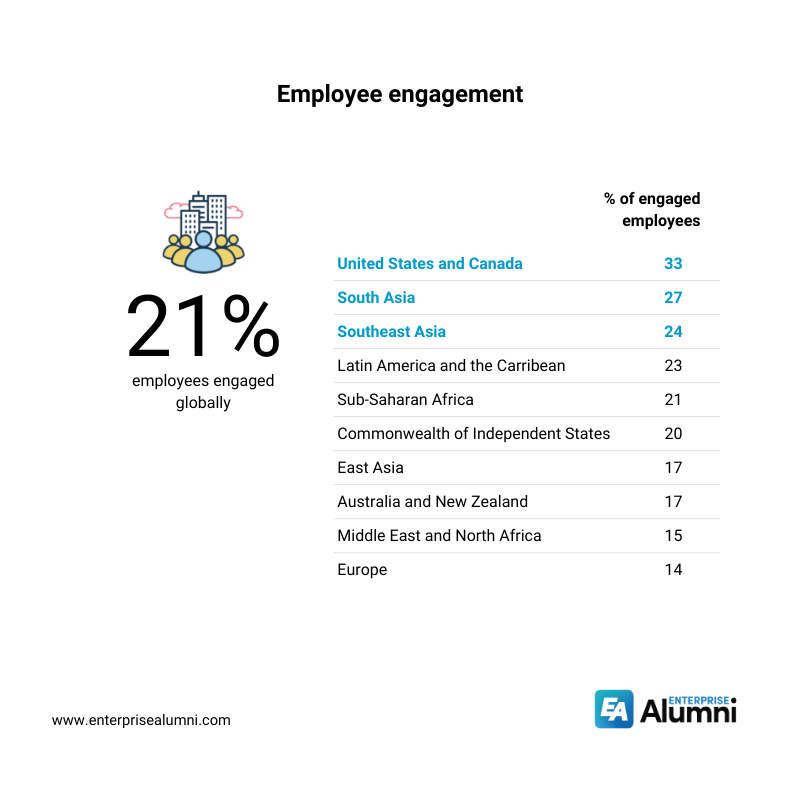
30. Disengaged employees have 37% higher absenteeism, 15% lower profitability, and 18% lower productivity. This translates to 34% of disengaged annual salary or $3,400 for every $10,000 they make. (21)
31. When employees have a sense of purpose in the organization, they are 49% more confident in its future and have 42% higher NPS. (22)
32. Leadership is the highest driver of engagement globally, with 78% of employees agreeing that they must stay in the organization. (23)
Employment Regulation Statistics
Employment law governs all aspects of employment. It is critical for any organization to follow the laws and provide its employees with expected working standards. Failing to comply can lead to penalties and also affect the well-being of your employees.
33. Thirty states and U.S. territories have laws that prohibit recruiters from requesting a candidate's salary history. (24)
34. As of 2022, 42 states have enacted equal pay laws to bring equality and transparency among employees, especially women. (25)
35. The 2020 Virginia status restricts the use of non-compete agreements for limited categories, mostly low-wage income. (26)
Job Interview Statistics
Job interviews have always been stressful for the candidate and the employer. Owing to escalating resignation rates and new job trends, it has become crucial for employers to provide the best interview experience to their candidates. Similarly, employees are burdened with finding their dream job and would love insights on how to crack their interviews.
36. On average, an employer interviews 6-10 candidates for a job, and those individuals then go through at least 2-3 rounds of interviews. (27)
37. The average response time for an interview is 24 business days, but it can vary across industries. The hospitality and recreation industry (39.5 days) is the highest, and government roles (16 days) take the lowest number of days to get back to candidates. (28)
38. According to research, C-suite candidates expect interview coaching (73%), immediate feedback (67%), and communication on all channels (69%) from employers during the recruitment process. (29)
39. Employers can use marketing automation tools to avoid being ghosted by applicants. Businesses had seen over 90% show rate when employers used marketing automation tools to remind candidates of their interview date.
40. Within the first 90 seconds, employers form an opinion about the candidate and whether they are hireable. (30)
41. The top industries see 12-17% interview-to-hire conversion. They also need 69% fewer candidates to make a hire. (31)
42. Video interviews are 6x faster than phone interviews and are used by 63% of hiring managers. (32)
43. 90.6% of employers prefer candidates with experience. Of these, 64.5% prefer candidates with relevant work experience, and 26.1% are fine with any type. (33)
Rehiring Statistics
Rehiring employees is not an uncommon practice, but it's definitely increasing in demand. Boomerang employees save you tons of money on hiring and have a high retention probability. If you are a hiring manager looking to rehire your old employees, check out these numbers:
44. Businesses can save 33-66% of recruiting costs when hiring a boomerang employee compared to a new hire. It's far less of a financial risk than hiring a new employee. (34)
45. Rehiring is said to be the best-performing source for hiring high-quality talent. It takes just 5 internal applications to result in 1 hire. (48)
46. Alumni Brand Advocates are worth 5x the value compared to an average customer. (35)
47. 98% of Fortune 500 companies have some Alumni Program (35)
48. Alumni programs drive 6x ROI on your recruitment program. Companies recruiting through alums programs can fill up to 20% of their openings. (36)
49. Boomerang hires made up 4.5% of new hires in the U.S. in 2021 – an increase from 3.9% in 2019. (37)
50. It takes an average of 17.3 months in the U.S. for employees to return to their previous employers. It is less than 11 months for arts and recreation and over 22 months for financial services. (38)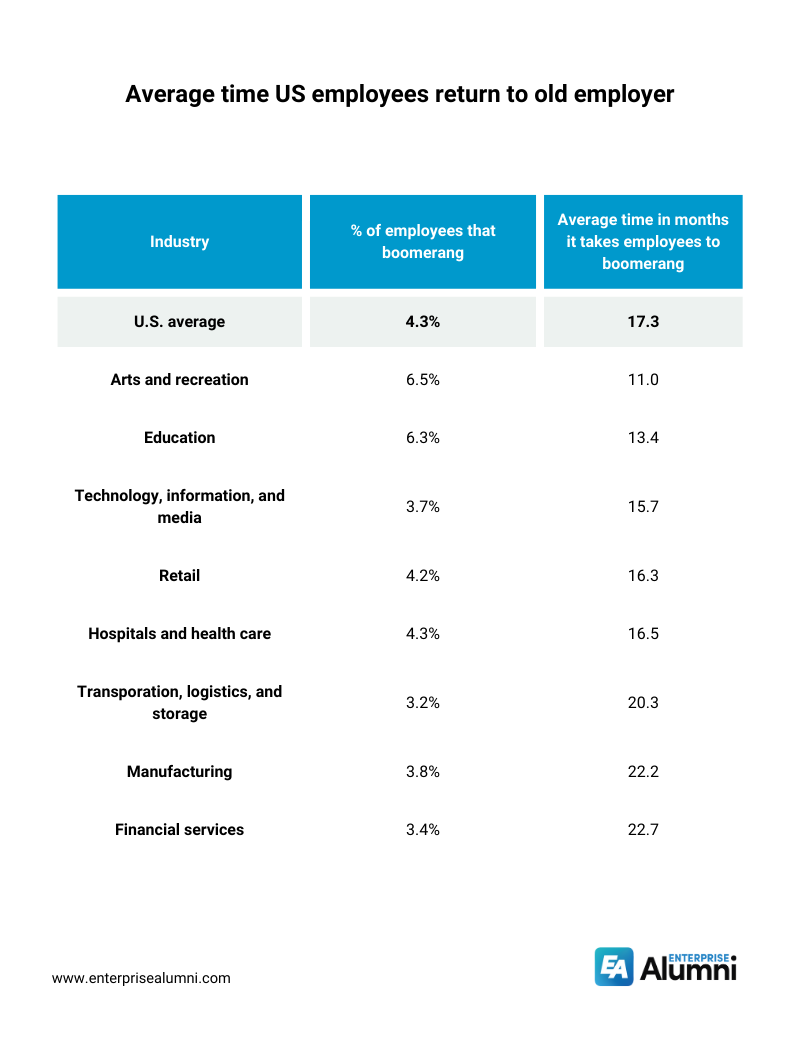
51. Boomerang employees are most likely to stay. U.S. Bureau of Labour Statistics (BLS) reported that the turnover rate for rehires in supermarkets and grocery stores were only 5.7% in 2021, while it was 65% for retail employees. (39)
52. Boomerang employees outperform new hires in their initial job spell, and this performance advantage is more in jobs that require greater internal coordination. (40)
The Main Problems with Hiring, Retaining & Rehiring in 2023
As an employer, you need to stay up to date on the latest hiring, retaining, and rehiring challenges to stay ahead of what's about to come. Check out these statistics to find out about the latest hiring trends and what candidates are looking for so you can make good hires.
53. H.R. professionals cited that their top three challenges for 2021 were labor shortage, legal and compliance issues, and health and safety concerns of their employees. (4)
54. A report by Microsoft, "The Next Great Disruption Is Hybrid Work – Are We Ready?" says 54% of Gen Z workers and 41% of the entire global workforce are considering leaving their employer. (41)
55. The top four priorities for HR in 2022 are:
- Maintaining employee morale and engagement (80%)
- Retaining top talent (78%)
- Finding and recruiting talent with the necessary skills (68%)
- Workplace safety practices (62%) (4)
56. A survey by Slack of 9000 employees in 6 countries found that 72% prefer a hybrid model and only 12% like work in the office setting. (42)
57. In the past, employers have seen 54% of candidates turn down offers due to a lack of flexibility and remote work options. 60% of organizations believe they will lose employees if they do not transition to a hybrid, fully remote, or remote-first culture. (6)
58. The top reason employees leave a job in 90 days is that the role was not as expected, followed by a bad experience, company culture, and unsatisfactory company leadership. (12) 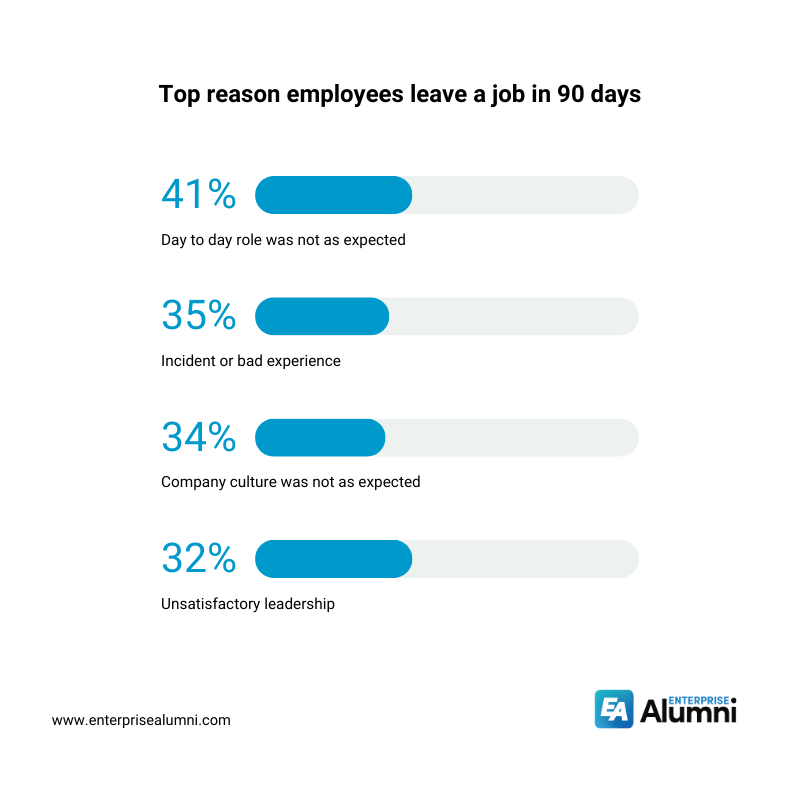
59. DE&I is important for people looking for jobs, and a large majority (86%) of candidates think about the company's investment when they're being hired. Diversity, equity, and inclusion (DE&I) features that employees are after:
- Employee benefits/ paid leaves (49%)
- Employee reviews on platforms like Glassdoor (47%)
- Diverse leadership team or board (34%)
- Promoting affinity/employee resource groups on the careers page (34%) (43)
60. The top reasons why candidates abandoned a recruitment process are salary expectations (54%), poor communication from the recruiter (53%), and lack of career advancement opportunities (38%). (44)![[ENTERPRISE ALUMNI] 2023 H.R. Statistics Hiring, Retaining & Rehiring Inline Images Template (800 × 1200 px)](https://enterprisealumni.com/hs-fs/hubfs/Research%20media%20files/%5BENTERPRISE%20ALUMNI%5D%202023%20H.R.%20Statistics%20Hiring%2c%20Retaining%20%26%20Rehiring%20Inline%20Images%20Template%20(800%20%C3%97%201200%20px).png?width=800&height=950&name=%5BENTERPRISE%20ALUMNI%5D%202023%20H.R.%20Statistics%20Hiring%2c%20Retaining%20%26%20Rehiring%20Inline%20Images%20Template%20(800%20%C3%97%201200%20px).png)
61. 63% of fully-remote companies struggle to retain employees, compared to 22% of fully or mostly in-office companies that reported similar challenges. (45)
62. According to Appcast, 92% of candidates never finish their job applications. (46)
Wrapping Up
That's it. These were some of the top statistics that could benefit the employer and the candidates. Recruitment today is complicated; you cannot start hiring without understanding the trends.
If you want to learn about corporate alumni networks and how to use them to hire talents, drive productivity, and reduce costs, then you should definitely check out EnterpriseAlumni.
Resources
-
The Future of Work (Monster)
-
Job Openings and Labor Turnover Summary (US Bureau of Labor Statistics)
-
The World's Workplace Is Broken -- Here's How to Fix It (Workplace)
-
State of the Workplace Study (SHRM)
-
State of the Global Workplace 2022 Report (Gallup)
-
New Research Reveals Priorities for Recruiters Amid the “Great Resignation” (Undercover Recruiter)
-
Research: Remote Work Now Accounts for Nearly 15% of All HighPaying Jobs (Ladders)
-
Social media recruitment statistics (StandOutCV)
-
Early Career Talent Teams Talk Recruitment Challenges & Strategies for Fall 2022 (RippleMatch)
-
SHRM HR Benchmarking Reports Launch as a Free Member-Exclusive Benefit (SHRM)
-
Can you wait 49 days? Why getting hired takes so long in engineering (Linkedln)
-
2022 Job Seeker Nation Report (Jobvite)
-
What is the average number of applicants per job in 2022? (EarthWeb)
-
State of Employee Engagement Q3 2021 (TinyCapsule)
-
LinkedIn Data Proves the Impact of a Strong Talent Brand (Linkedln)
-
The ROI of Employee Engagement: Show Me the Money! (DecisionWise)
-
Understanding and calculating the cost of employee turnover (Culture Amp)
-
HR Industry Benchmark Survey 2021:Your 2022 Report (elmsoftware)
-
Why are employees everywhere but at work? (LinkedIn)
-
2021 Engagement Report (PeopleElement)
-
How Much Are Your Disengaged Employees Costing You? (Forbes)
-
How to keep your employees engaged during the COVID-19 pandemic (Effectory)
-
All Industries (Global) 2022, June Update (Culture Amp)
-
States with Salary History Bans (Paycor)
-
Pay Equity and State-by-State Laws (Paycor)
-
Non Competence Agreements 2022 wages update (Lynchburg Regional SHRM)
-
How Many Interviews For One Job? (CareerSidekick)
-
What Is the Average Response Time After an Interview? (Indeed)
-
The future of recruiting (PWC)
-
How Interviewers Know When to Hire You in 90 Seconds? (Undercover Recruiter)
-
Benchmark Data by Industry (Careerplug)
-
Companies Use Video Interviewing More Than You Think (SparkHire)
-
Employers prefer candidates with work experience (Nace)
-
Can't fill that job? Look to familiar faces (Advisory Board)
-
The Data On Corporate Alumni (EnterpriseAlumni)
-
Alumni Insights 2019 (EnterpriseAlumni)
-
Why Boomerang Employees Will Become More Common (LinkedIn)
-
Welcome back! Employers rush to hire talent that left just 17 months ago (LinkedIn)
-
Boomerang employees: Why rehires are invaluable to your organization and how to retain them (Ceridian Logo)
-
In With the Old? Examining When Boomerang Employees Outperform New Hires (Academy of Management)
-
The Next Great Disruption Is Hybrid Work – Are We Ready (Microsoft)
-
Moving beyond remote: Workplace transformation in the wake of Covid-19 (Slack)
-
Greenhouse Study Shows Job Seekers Face Lengthy Applications, Slow Recruiter Response Times, Ghosting And Unprepared, Late Interviewers (Forbes)
-
Candidate Experience Report (Criteria)
-
Companies That Prioritize Candidate Relationships Improve Hiring Performance According to Hiring Insights Report From GoodTime (GlobalNewsWire)
-
Most People—92%—Never Finish Online Job Applications (SHRM)
-
Roles offering sign-on bonus increase by a whopping 454% amid staff shortages (GlobalData)
-
9 Recruitment trends for 2022 (Page Up)

